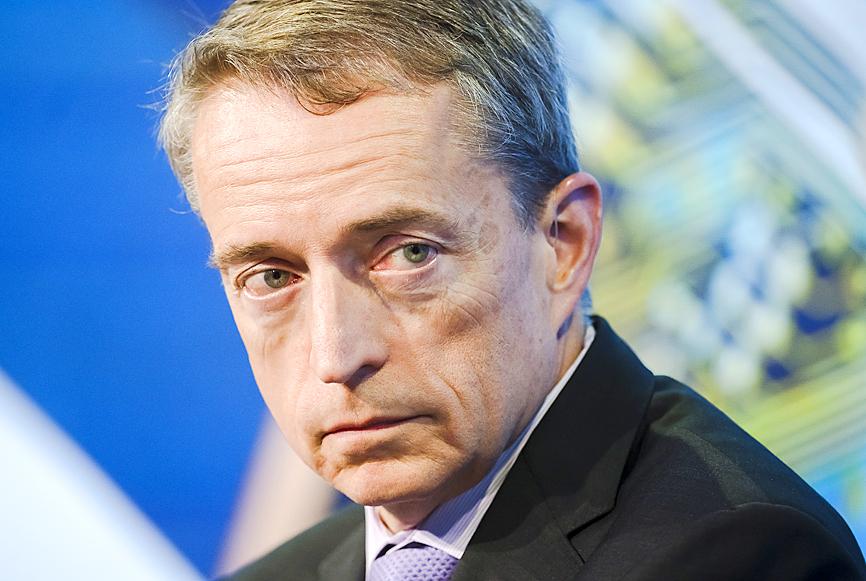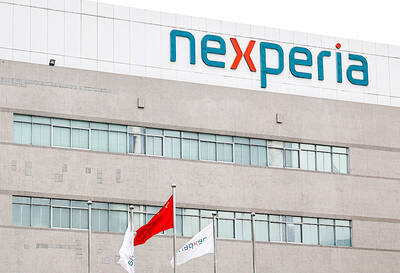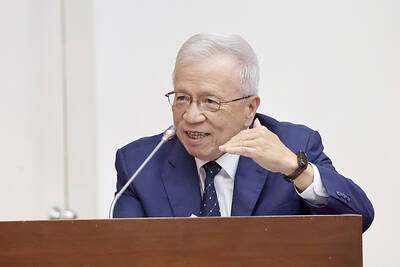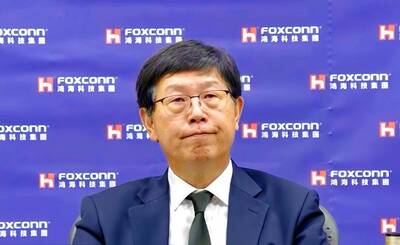Intel Corp CEO Pat Gelsinger slashed sales and profit forecasts for the rest of the year, conceding that the struggling chipmaker needs more time to make its products competitive while assuring investors that this quarter would be the nadir.
The company, which in April reiterated its annual sales forecast, reported steeply lower second-quarter results and said revenue would this year be as much as US$11 billion less than projected, buffeted by a slackening economy and a share loss in the server market.
“It feels like they’re clearing out a lot of the bad news,” said Matt Bryson, an analyst at Wedbush Securities, adding that Intel should have cut projections several quarters earlier.

Photo: EPA-EFE
“If you believe in Intel, you believe in Intel in 2024, or 2025 or 2026,” he added.
The company’s shares tumbled as much as 12 percent in late trading after it gave disappointing sales and profit estimates for this quarter and reduced forecasts for the year.
Annual revenue would be as low as US$65 billion, the company said.
That would be a decline of as much as 13 percent from last year.
While investors had anticipated that a PC slump would weigh on Intel’s second-quarter performance, an unexpected 16 percent drop in revenue from expensive server chips that power data centers dragged down overall sales and profit.
Prices are falling and customers have been turning to rival providers for their orders, Intel said.
The majority of Intel’s shortfall was caused by a slowdown in the economy, but the company’s failure to produce better products on time also contributed to the miss, Gelsinger said.
This quarter would be the low point for Intel’s performance, he said, adding that many of its customers are working through unused stockpiles of chips and have not placed new orders, but would soon need to resume those purchases.
“We feel very confident that it’s the bottom,” Gelsinger said in an interview.
On Thursday, Gelsinger said a delayed server product this quarter hurt Intel, a result of the legacy of projects begun before he rejoined the company last year.
In the second quarter, revenue fell 22 percent to US$15.3 billion, significantly below the average analyst estimate of US$18 billion.
Profit per share excluding some items was US$0.29, Intel said, while analysts had predicted US$0.69.
Sales would this quarter be as low as US$15 billion, compared with projections of $18.7 billion, and gross margin would narrow to 47 percent, Intel said.
Gelsinger said he is not backing off a plan to spend heavily on improving Intel’s manufacturing technology.
The “austerity” of the decline in the economy and Intel’s performance would help the company place its big bets more strategically, while cutting back on areas that are not key to its future, he said.
Second-quarter sales for Intel’s data center division, which generates an outsize portion of profit, slid to US$4.6 billion, missing the average analyst estimate of US$6.04 billion.
The company expects its data center business to grow more slowly than the overall server market this year, Gelsinger said.
Client computing, Intel’s PC chip unit, saw sales plummet 25 percent to US$7.7 billion, compared with an average projection of US$8.76 billion.
The company’s new target for this year’s revenue is US$65 billion to US$68 billion.
Intel said that gross margin would be 49 percent this year, 9.1 points narrower than a year earlier and 3 points shy of what the company had targeted.
That metric of profitability, once touted as an indication of Intel’s strength, is being squeezed by increasing competition and is now more than 10 points narrower than the company’s annual gross margins for much of the past decade.

JITTERS: Nexperia has a 20 percent market share for chips powering simpler features such as window controls, and changing supply chains could take years European carmakers are looking into ways to scratch components made with parts from China, spooked by deepening geopolitical spats playing out through chipmaker Nexperia BV and Beijing’s export controls on rare earths. To protect operations from trade ructions, several automakers are pushing major suppliers to find permanent alternatives to Chinese semiconductors, people familiar with the matter said. The industry is considering broader changes to its supply chain to adapt to shifting geopolitics, Europe’s main suppliers lobby CLEPA head Matthias Zink said. “We had some indications already — questions like: ‘How can you supply me without this dependency on China?’” Zink, who also

At least US$50 million for the freedom of an Emirati sheikh: That is the king’s ransom paid two weeks ago to militants linked to al-Qaeda who are pushing to topple the Malian government and impose Islamic law. Alongside a crippling fuel blockade, the Group for the Support of Islam and Muslims (JNIM) has made kidnapping wealthy foreigners for a ransom a pillar of its strategy of “economic jihad.” Its goal: Oust the junta, which has struggled to contain Mali’s decade-long insurgency since taking power following back-to-back coups in 2020 and 2021, by scaring away investors and paralyzing the west African country’s economy.

BUST FEARS: While a KMT legislator asked if an AI bubble could affect Taiwan, the DGBAS minister said the sector appears on track to continue growing The local property market has cooled down moderately following a series of credit control measures designed to contain speculation, the central bank said yesterday, while remaining tight-lipped about potential rule relaxations. Lawmakers in a meeting of the legislature’s Finance Committee voiced concerns to central bank officials that the credit control measures have adversely affected the government’s tax income and small and medium-sized property developers, with limited positive effects. Housing prices have been climbing since 2016, even when the central bank imposed its first set of control measures in 2020, Chinese Nationalist Party (KMT) Legislator Lo Ting-wei (羅廷瑋) said. “Since the second half of

AI BOOST: Next year, the cloud and networking product business is expected to remain a key revenue pillar for the company, Hon Hai chairman Young Liu said Manufacturing giant Hon Hai Precision Industry Co (鴻海精密) yesterday posted its best third-quarter profit in the company’s history, backed by strong demand for artificial intelligence (AI) servers. Net profit expanded 17 percent annually to NT$57.67 billion (US$1.86 billion) from NT$44.36 billion, the company said. On a quarterly basis, net profit soared 30 percent from NT$44.36 billion, it said. Hon Hai, which is Apple Inc’s primary iPhone assembler and makes servers powered by Nvidia Corp’s AI accelerators, said earnings per share expanded to NT$4.15 from NT$3.55 a year earlier and NT$3.19 in the second quarter. Gross margin improved to 6.35 percent,